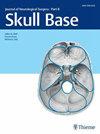Idiopathic Intracranial Hypertension is Associated with Recurrent CSF Leak and Reoperation for Spontaneous Temporal Encephalocele
IF 0.9
4区 医学
Q3 Medicine
引用次数: 0
Abstract
Objective: Spontaneous temporal encephaloceles (STEs) are increasingly recognized as sequelae of idiopathic intracranial hypertension (IIH), which in turn may further complicate their management. We endeavored to review the University of Pennsylvania institutional experience on operative management of STEs, with a focus on factors which may influence surgical outcomes, particularly IIH. Design: Retrospective chart review over 9 years from 2013 – 2022. Setting: Single-center, two-hospital, tertiary care, academic setting. Participants: Patients undergoing middle cranial fossa (MCF, 43.9%), transmastoid (TM, 44.9%) or combined (11.2%) approaches for repair of STEs during the study period (n=107). Main Outcome Measures: Post-operative complication rates, recurrence and diagnosis of IIH. Results: The majority of patients were female (64.5%), with a mean BMI of 37 kg/m2 and mean age of 57 years. Twelve patients (9%) represented re-operations after failed primary repairs. Fourteen percent of patients undergoing primary surgical repair of STE were diagnosed with IIH, compared to 42% of patients undergoing re-operations (p = 0.015). In addition, there was a significant difference in the average BMI of patients undergoing primary (36.4 kg/m2) versus revision surgery (40.9 kg/m2, p=0.04). Half of those undergoing re-operation were placed on post-operative acetazolamide compared to 11% of patients undergoing primary operations. No patient experienced recurrent leak after re-operation. Conclusion: Based on our institutional experience, elevated BMI and the presence of IIH are significant predictors of re-operation for STE. In our experience, acetazolamide is a common adjunct management strategy in addition to re-operation for patients with recurrent CSF leak in the setting of STE.特发性颅内高压与脑脊液漏复发及自发性颞叶脑膨出再手术有关
目的:自发性颞叶脑泡(STEs)越来越多地被认为是特发性颅内高压(IIH)的后遗症,这可能进一步使其治疗复杂化。我们努力回顾宾夕法尼亚大学在STEs手术管理方面的机构经验,重点关注可能影响手术结果的因素,特别是IIH。设计:回顾2013 - 2022年9年的图表。环境:单中心、双医院、三级保健、学术环境。参与者:在研究期间接受中颅窝(MCF, 43.9%)、经乳突(TM, 44.9%)或联合(11.2%)入路修复STEs的患者(n=107)。主要观察指标:IIH术后并发症发生率、复发率及诊断。结果:患者以女性居多(64.5%),平均BMI为37 kg/m2,平均年龄57岁。12例(9%)患者在初次修复失败后再次手术。接受STE初次手术修复的患者中有14%被诊断为IIH,而再次手术的患者中有42%被诊断为IIH (p = 0.015)。此外,初次手术患者的平均BMI (36.4 kg/m2)与翻修手术患者的平均BMI (40.9 kg/m2, p=0.04)存在显著差异。接受再次手术的患者中有一半在术后使用乙酰唑胺,而接受首次手术的患者中这一比例为11%。再次手术后无复发渗漏。结论:根据我们的机构经验,BMI升高和IIH的存在是STE再次手术的重要预测因素。根据我们的经验,对于STE患者复发性脑脊液泄漏,除了再手术外,乙酰唑胺是一种常见的辅助治疗策略。
本文章由计算机程序翻译,如有差异,请以英文原文为准。
求助全文
约1分钟内获得全文
求助全文
来源期刊

Journal of Neurological Surgery Part B: Skull Base
CLINICAL NEUROLOGY-SURGERY
CiteScore
2.20
自引率
0.00%
发文量
516
期刊介绍:
The Journal of Neurological Surgery Part B: Skull Base (JNLS B) is a major publication from the world''s leading publisher in neurosurgery. JNLS B currently serves as the official organ of several national and international neurosurgery and skull base societies.
JNLS B is a peer-reviewed journal publishing original research, review articles, and technical notes covering all aspects of neurological surgery. The focus of JNLS B includes microsurgery as well as the latest minimally invasive techniques, such as stereotactic-guided surgery, endoscopy, and endovascular procedures. JNLS B is devoted to the techniques and procedures of skull base surgery.
 求助内容:
求助内容: 应助结果提醒方式:
应助结果提醒方式:


